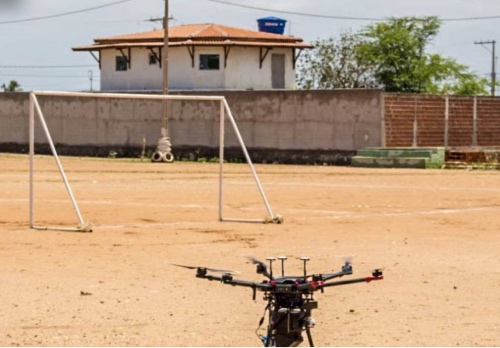Millions of sterile mosquitoes will be released from drones over parts of Brazil to combat the Zika virus, after successful field tests were hailed as a “breakthrough” by the United Nations.
Once freed, the sterilised, laboratory-bred male Aedes aegypti mosquitoes – which spread Zika, dengue and yellow fever by biting humans – mate with females, but do not produce viable eggs, said the UN’s International Atomic Energy Agency.

A drone carrying sterile mosquitoes being tested in Juazeiro, north-eastern Brazil. PICTURE: Courtesy of WeRobotics.
“You can reduce the mosquito population over time and suppress the next generation of mosquitoes by up to 99 per cent,” said Jeremy Bouyer, an IAEA scientist.
“Before we had no way to release mosquitoes by air. But now, with the use of drones, this is a breakthrough as it allows mosquitoes to be released on a large scale and it reduces the cost a lot,” he told the Thomson Reuters Foundation.
Brazil was hard hit by the 2015 to 2016 Zika epidemic, a virus linked to birth defects in thousands of babies.
Until now, sterile mosquitoes have been released using time-consuming and labor-intensive methods, often using trucks, with some areas cut off by poor roads and flooding.
The IAEA, the UN’s Food and Agriculture Organization and the non-profit WeRobotics, which uses technology for development, released about 280,000 mosquitoes in a test using specially adapted drones in northeastern Brazil last month.
“Using the drone, to treat 20 hectares, it only took us five minutes,” Dr Bouyer said.
Brazil plans to release to up to one million mosquitoes a week over a period of three months in late 2017 or early 2018, at the peak of the mosquito season, near the northeastern cities of Juazeiro and Recife, he said.
“As far as I know, this is the first time that such a large amount of mosquitoes have actually been successfully released from a drone,” said Adam Klaptocz, co-founder of WeRobotics.
“We are providing the way of releasing very large amounts of mosquitoes into the environment in a scalable and efficient way.”
Improvements are being made to the drone, which can be bought “off the shelf”, and to the software so that more mosquitoes can be carried on each flight, he said.
Since the pilot, Thailand, Singapore, Montenegro and Greece have expressed interest in trialing drone releases of sterile mosquitoes to reduce the insect’s populations, Dr Bouyer said.
Several million people die every year from diseases spread by mosquitoes, according to the World Health Organization.






